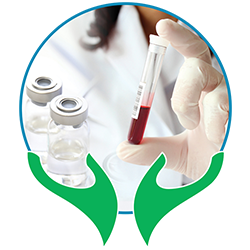-
 Amylase
Amylase Amylase - Parameters: 1
A class of hydrolases known as amylases breaks down complex carbs into smaller pieces. To help break down starch, the salivary glands and exocrine pancreas generate amylase. The mucosa of the small intestine, the ovaries, the placenta, the liver, and the fallopian tubes all manufacture it as well. Pancreatic diagnostics heavily relies on α-amylase findings due to the scarcity of some clinical signs associated with pancreatic disorders. They are mostly employed in the identification and observation of acute pancreatitis. H However, macroamylasemia can also occur in cases of renal failure (reduced glomerular filtration), ovaries or lung tumours, pulmonary inflammation, diseases of the salivary gland, diabetic ketoacidosis, cerebral trauma, surgical procedures, and acute pancreatitis or the inflammatory phase of chronic pancreatitis.
-
 C- Reactive Protein
C- Reactive Protein C- Reactive Protein - Parameters: 1
The traditional acute phase protein for inflammatory responses is C-reactive protein. A substantial acute chase response of C-reactive protein (CRP) is linked to most tissue-damaging events, including infections, inflammatory disorders, and malignant neoplasms. Often, the CRP response occurs before clinical signs, such as fever.
-
 Calcium
Calcium Calcium - Parameters: 1
99 percent of the calcium in the body is found in the bones as hydroxyapatite, making calcium the most common mineral in the body. The leftover calcium is spread throughout the body's tissues and extracellular fluids, where it is essential to numerous functions that support life. Calcium is involved in blood coagulation, neuromuscular conduction, excitability of skeletal and cardiac muscle, enzyme activation, and maintenance of cell membrane integrity and permeability, among other extraskeletal functions. Vitamin D, calcitonin, and parathyroid hormone (PTH) regulate serum calcium levels and, by extension, body content. Serum PTH or vitamin D increases are typically linked to hypercalcemia. Other neoplastic disorders such as multiple myeloma may also be associated with elevated serum calcium levels. In conditions including pancreatitis, nephrosis, and hypoparathyroidism, hypocalcemia may be seen
-
 Creatinine Kinase
Creatinine Kinase Creatinine Kinase - Parameters: 1
Creatinine kinase (CK), an enzyme found primarily in muscles and the heart, is essential for energy production. Elevated CK levels in the bloodstream often indicate muscle damage or heart issues, making it a valuable diagnostic marker. Our laboratory offers precise CK testing, aiding in the timely diagnosis and monitoring of conditions such as heart attacks and muscle diseases. Trust our comprehensive lab services for accurate healthcare assessments and proactive management of your well-being.
-
 Erythrocyte Sedimentation Rate
Erythrocyte Sedimentation Rate Erythrocyte Sedimentation Rate - Parameters: 1
The Erythrocyte Sedimentation Rate (ESR) test measures the rate at which red blood cells settle in a tube of blood over time. It is a nonspecific indicator of inflammation in the body, with elevated rates suggesting the presence of inflammation or infection. Despite its nonspecificity, ESR is valuable in diagnosing and monitoring conditions like autoimmune diseases, infections, and certain cancers. Our laboratory provides accurate ESR testing to aid in timely diagnoses and effective treatment plans.
-
 Ferritin
Ferritin Ferritin - Parameters: 1
Ferritin is a macromolecule that has a molecular weight of at least 440 kD, depending on the amount of iron present. It is composed of an iron core that has an average of about 2500 Fe3+ ions (in liver and spleen ferritin) and a protein shell (apoferritin) with 24 subunits. Ferritin measurement is a useful technique for determining the state of iron metabolism. A representative measurement of the body's iron reserves can be obtained by measuring ferritin at the start of treatment. Early detection is possible when it comes to reticulo-endothelial system (RES) storage deficiencies.
-
 Folate
Folate Folate - Parameters: 1
Deficiency in folate can lead to nutritional and macrocytic anaemias. Diets lacking in raw fruits, vegetables, or other foods high in folic acid can cause this deficit; this can be the case for those who are chronic alcoholics, drug addicts, old, from low-income backgrounds, etc. Furthermore, neural tube abnormalities in the foetus have been linked to low serum folate levels during pregnancy. 1 The two main causes of folate insufficiency in humans are malabsorption and dietary deficiencies. 2. Red blood cell regeneration, DNA synthesis, and proper metabolism all depend on folate. Megaloblastic anaemia can result from untreated deficiencies. To accurately evaluate the aetiology of anaemia, it is recommended to measure the concentration of both vitamin B12 and folate because deficiencies in any of these nutrients might result in megaloblastic anaemia.
-
 Free Thyroxine
Free Thyroxine Free Thyroxine - Parameters: 1
The primary thyroid hormone that the thyroid gland secretes into the bloodstream is called thyroxine (T4). In conjunction with triiodothyronine (T3), it is essential for controlling the body's metabolic rate, as well as growth, bone metabolism, cardiovascular health, and the proper development of the brain system and gonadal organs. In the bloodstream, T4 is a balanced combination of free and serum-bound hormone. The unbound, physiologically active version of T4 is called free T4 (fT4). One benefit of measuring free T4 is that it remains unaffected by variations in the quantities and characteristics of these binding proteins. In clinical routine diagnostics, free T4 is a helpful tool for determining the thyroid health. If thyroid issues are suspected, it should be examined along with TSH. It can also be used to track the effects of thyrosuppressive medication.
-
 Full Blood Count
Full Blood Count Full Blood Count - Parameters: 1
Full Blood Count
-
 Iron
Iron Iron - Parameters: 1
Transferrin is a protein that moves iron from the intestine to cells that need it. The iron test measures how much iron transferrin carries. The blood's iron content fluctuates throughout the day and from day to day. Therefore, if an iron blood (serum) test is taken in isolation, it is not a helpful indicator of iron status. For this reason, serum iron is frequently asked for in addition to other iron status tests. Transferrin, ferritin, TIBC (total iron binding capacity), and UIBC (unbound iron binding capacity) are a few examples of these tests. If a physician detects iron poisoning or diseases related to high iron storage, they will order iron tests. Hereditary hemochromatosis is a genetic disorder that can cause excessive iron accumulation, although it can also happen after receiving several blood transfusions. Measurements are made of both transferrin and iron concentrations if iron excess is suspected. The extent of the iron overload can then be calculated using transferrin saturation. Transferrin saturation indicates how much iron is being carried by the blood and how much more it can hold.
-
 Lactate Dehydrogenase
Lactate Dehydrogenase Lactate Dehydrogenase - Parameters: 1
Lactate dehydrogenase (LDH) is an enzyme crucial for energy production in cells, converting lactate to pyruvate during anaerobic metabolism. Elevated LDH levels can indicate tissue damage or disease, making it a valuable marker in diagnostics. Our laboratory provides accurate LDH testing, aiding in the diagnosis and monitoring of various conditions. Learn more about LDH and its clinical significance through our comprehensive lab services, ensuring precise healthcare assessments.
-
 Lipid Profile
Lipid Profile Lipid Profile - Parameters: 6
Lipid Profile
-
 Liver Function
Liver Function Liver Function - Parameters: 8
Liver Function
-
 Phosphorus
Phosphorus Phosphorus - Parameters: 1
Phosphorus, an essential mineral, plays a pivotal role in various bodily functions. It contributes to bone health, energy metabolism, and cellular structure. Phosphorus also participates in the formation of DNA and RNA, vital for genetic processes. Our lab offers precise tests to monitor phosphorus levels, ensuring optimal bodily function. Explore the significance of phosphorus and its impact on overall health through our comprehensive laboratory services.
-
 Prostate Specific Antigen
Prostate Specific Antigen Prostate Specific Antigen - Parameters: 1
A glycoprotein with a molecular weight of 30.000–34000 daltons, prostate-specific antigen (PSA) shares a tight structural link with glandular kallikreins. Prostatatitis, benign hyperplasia, or cancer are the three pathologic conditions of the prostate that are typically indicated by elevated PSA concentrations in the serum. Low levels of PSA can also be seen in female sera since it is also found in the paraurethral and anal glands, breast tissue, and breast cancer. Radiation prostatectomy may not completely remove PSA from the body. PSA readings are primarily used in the tracking of treatment efficacy and progress in patients with prostate cancer or undergoing hormone therapy. The success of therapy can be determined by observing the steepness of the PSA decline to levels that are no longer detectable after radiation, hormonal therapy, or drastic surgical excision of the prostate. PSA rises might be of different lengths and degrees due to prostate inflammation or trauma (e.g., after rectal examination, transurethral biopsy, cystoscopy, coloscopy, laser treatment, or ergometry).
-
 Renal Function
Renal Function Renal Function - Parameters: 6
Renal Function
-
 Thyroid Stimulating Hormone
Thyroid Stimulating Hormone Thyroid Stimulating Hormone - Parameters: 1
Thyrotropin, also known as thyroid stimulating hormone (TSH), is a glycoprotein made up of two subunits and with a molecular weight of about 30,000 daltons. TSH has a diurnal secretion sequence and is produced in particular basophil cells of the anterior pituitary. The primary regulatory mechanism for the biological action of thyroid hormones is the hypophyseal release of thyrotropic hormone (TSH). TSH has a proliferative effect in addition to boosting thyroid hormone production and secretion at all stages. The first test in thyroid diagnostics is the measurement of TSH. The TSH level responds significantly more strongly to even minute variations in the free thyroid hormone concentrations. As a result, TSH is an extremely sensitive and precise metric for evaluating thyroid function. It is especially well-suited for the early identification or rule-out of illnesses affecting the major regulatory circuit that connects the thyroid, pituitary, and brain.
-
 Uric Acid
Uric Acid Uric Acid - Parameters: 1
The end result of purine metabolism in the human body is uric acid. Measurements of uric acid are utilised in the diagnosis and treatment of several metabolic and renal illnesses, such as gout, leukaemia, psoriasis, hunger or other wasting syndromes, renal failure, and patients on cytotoxic medicines.










